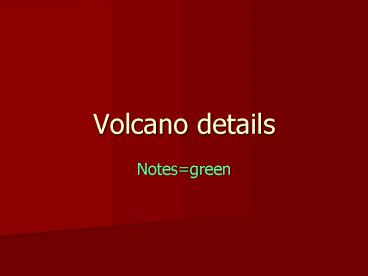Volcano details - PowerPoint PPT Presentation
1 / 15
Title:
Volcano details
Description:
Types of pyroclastics. There are 4 main types/sizes ... Types of pyroclastics ... Alternating layers of lava and pyroclastics form broad bases with steep sides. ... – PowerPoint PPT presentation
Number of Views:64
Avg rating:3.0/5.0
Title: Volcano details
1
Volcano details
- Notesgreen
2
Types of Lava
- As we talked about last class, there are
different types of explosions due to the amounts
of water and silica. - Similarly, depending on the amount of water and
silica, the way the lava flows out of a non
explosive volcano can change.
3
4 types of lava
- Lava is based on how it moves out and away from
the volcano. - Blocky lava Cool and stiff, it does not travel
far from the volcano. It usually oozes out after
an explosive eruption. - Pahoehoe (pah HOY HOY) slow flowing like wax
dripping from a candle. It has a rope-like
appearance.
4
4 types of lava
- Aa (AH ah) This lava has a jagged surface and
pours out of a volcano much quicker. It is
brittle and hardens quickly, allowing for molten
rock to flow underneath. It is named after the
sound you would make if you walked across it
barefoot. - Pillow lava The result of lava erupting
underwater. The water causes rapid cooling and
results in bubble like pillows.
5
Can you identify these lavas?
6
Explosive lava
- If it doesnt flow out of the volcano, it gets
blasted from the volcano. These blasted pieces
can range in size. Pyroclastic material (or
pieces shot from the volcano) are classified by
their sizes.
7
Types of pyroclastics
- There are 4 main types/sizes ejected from
explosive eruptions - Volcanic blocks Solid chunks of rock blasted
from the volcano, they are basically chunks of
the volcano top. - Volcanic bombs Large blobs of magma that harden
in the air. They often form tear-drop shapes as
they fly through the air. They are larger than
64mm in diameter.
8
Types of pyroclastics
- Lapilli (La pill ee) Meaning little stones in
Italian, these are pebble-like pieces that range
from 2mm to 64mm. - Volcanic Ash Particles that are less than 2mm in
diameter. Ash forms when gases force magma to
explode into tiny pieces.
9
Can you identify these pyroclastics?
10
Types of Volcanoes
- Shield Volcano
- Layers of lava from repeated non-explosive
eruptions. - Wide with a gentle slope.
- Often the tallest because it is always increasing
in size, never decreasing.
11
Types of Volcanoes
- Cinder cone volcano
- Small volcanic cones made from its own
pyroclastic material. - Has a steeper slope with a narrower base.
- They often erode quickly because they are not
cemented down by lava.
12
Types of Volcanoes
- Composite Volcano (Stratovolcano)
- The most common type of volcano.
- They form by explosive eruptions followed by lava
flows. - Alternating layers of lava and pyroclastics form
broad bases with steep sides.
13
Craters and Calderas
- Craters A funnel-shaped pit at the top of the
central vent of a volcano. - Caldera A large hole formed when the magma
chamber empties and collapses.
Click here to learn about calderas that form in
the US.
14
Build your own volcano
- Volcano Simulator
15
Volcano Lab
- Creating the rubric
- Scale of 1-4
- Define categories
- Examples from last year































